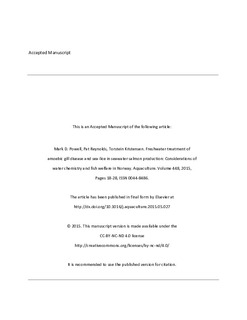Freshwater treatment of amoebic gill disease and sea-lice in seawater salmon production : Considerations of water chemistry and fish welfare in Norway
Journal article, Peer reviewed
Accepted version
Permanent lenke
http://hdl.handle.net/11250/2574128Utgivelsesdato
2015Metadata
Vis full innførselSamlinger
Originalversjon
Powell, M. D., Reynolds, P. & Kristensen, T. (2015). Freshwater treatment of amoebic gill disease and sea-lice in seawater salmon production: Considerations of water chemistry and fish welfare in Norway. Aquaculture, 448, 18-28. doi: 10.1016/j.aquaculture.2015.05.027Sammendrag
Amoebic gill disease (AGD) and sea lice are two of the most significant disease issues that the Norwegian Atlantic salmon aquaculture industry is facing. Although both diseases respond to various extents, to freshwater treatment, the chemistry, interactions, and efficacy of treatment can be variable. These variations can have significant impacts upon the success and failure of treatment and costs to the production cycle. Although it is known that soft freshwater is most effective in bathing of Atlantic salmon with AGD and that most of the freshwaters in Norway fall into the soft category, the low alkalinity and buffering capacity of such waters may impact on the pH and metal toxicity of the water source in use. Similarly dissolved organic carbon can be beneficial in treatment, although sequestration of metal ions can be reversed as the water pH drops due to high densities of fish and accumulations of carbon dioxide. Alternative treatments such as the use of oxidative disinfectants such as hydrogen peroxide used for AGD and sea lice control may have potential although the interactions in seawater with organic loads and dissolved organic carbon are unclear. Similarly the use of oxidative disinfectants in freshwater will depend upon the water chemistry and interactions with treatment chemicals, fish, and water organic content. The logistics of treating large biomasses of Atlantic salmon on marine farms are challenging. The use of well boats offers potential although maintaining water quality during treatments is essential for both AGD and sea lice treatments to optimize fish welfare and treatment efficacy.
Beskrivelse
Author's accepted version (post-print).

